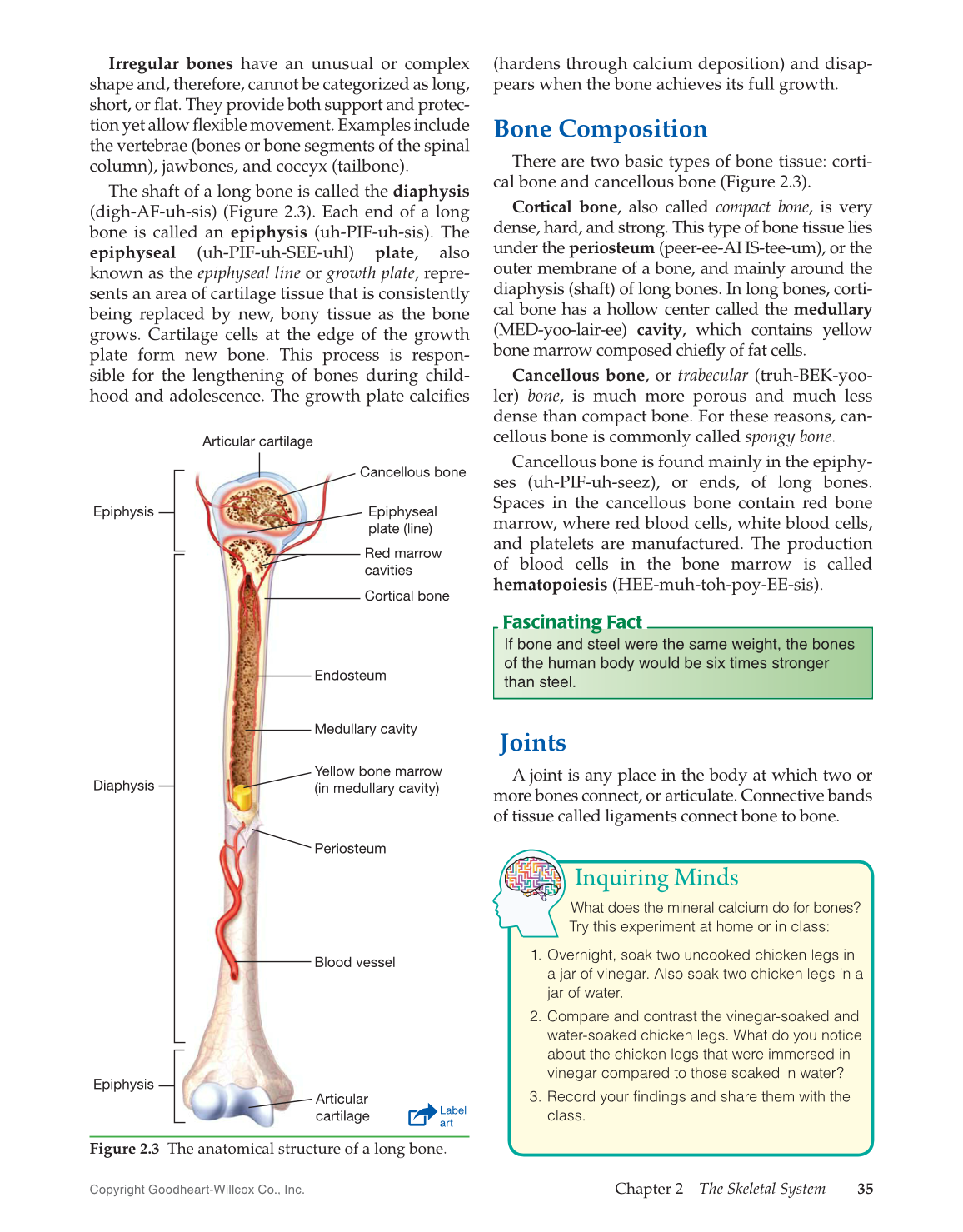Copyright Goodheart-Willcox Co., Inc.
Chapter 2 The Skeletal System 35
Irregular bones have an unusual or complex
shape and, therefore, cannot be categorized as long,
short, or fl at. They provide both support and protec-
tion yet allow fl exible movement. Examples include
the vertebrae (bones or bone segments of the spinal
column), jawbones, and coccyx (tailbone).
The shaft of a long bone is called the diaphysis
(digh-AF-uh-sis) (Figure 2.3). Each end of a long
bone is called an epiphysis (uh-PIF-uh-sis). The
epiphyseal (uh-PIF-uh-SEE-uhl) plate, also
known as the epiphyseal line or growth plate, repre-
sents an area of cartilage tissue that is consistently
being replaced by new, bony tissue as the bone
grows. Cartilage cells at the edge of the growth
plate form new bone. This process is respon-
sible for the lengthening of bones during child-
hood and adolescence. The growth plate calcifi es
(hardens through calcium deposition) and disap-
pears when the bone achieves its full growth.
Bone Composition
There are two basic types of bone tissue: corti-
cal bone and cancellous bone (Figure 2.3).
Cortical bone, also called compact bone, is very
dense, hard, and strong. This type of bone tissue lies
under the periosteum (peer-ee-AHS-tee-um), or the
outer membrane of a bone, and mainly around the
diaphysis (shaft) of long bones. In long bones, corti-
cal bone has a hollow center called the medullary
(MED-yoo-lair-ee) cavity, which contains yellow
bone marrow composed chiefl y of fat cells.
Cancellous bone, or trabecular (truh-BEK-yoo-
ler) bone, is much more porous and much less
dense than compact bone. For these reasons, can-
cellous bone is commonly called spongy bone.
Cancellous bone is found mainly in the epiphy-
ses (uh-PIF-uh-seez), or ends, of long bones.
Spaces in the cancellous bone contain red bone
marrow, where red blood cells, white blood cells,
and platelets are manufactured. The production
of blood cells in the bone marrow is called
hematopoiesis (HEE-muh-toh-poy-EE-sis).
Joints
A joint is any place in the body at which two or
more bones connect, or articulate. Connective bands
of tissue called ligaments connect bone to bone.
If bone and steel were the same weight, the bones
of the human body would be six times stronger
than steel.
Fascinating Fact
Figure 2.3 The anatomical structure of a long bone.
Inquiring Minds
What does the mineral calcium do for bones?
Try this experiment at home or in class:
1. Overnight, soak two uncooked chicken legs in
a jar of vinegar. Also soak two chicken legs in a
jar of water.
2. Compare and contrast the vinegar-soaked and
water-soaked chicken legs. What do you notice
about the chicken legs that were immersed in
vinegar compared to those soaked in water?
3. Record your findings and share them with the
class.
Periosteum
Epiphysis
Diaphysis
Epiphysis
Articular cartilage
Articular
cartilage
Endosteum
Blood vessel
Yellow bone marrow
(in medullary cavity)
Medullary cavity
Cortical bone
Epiphyseal
plate (line)
Cancellous bone
Red marrow
cavities
Label
art
